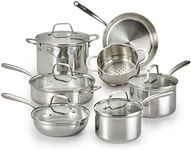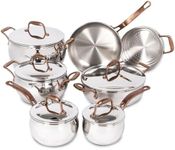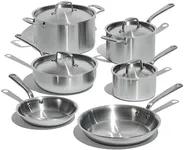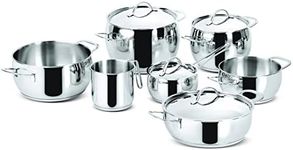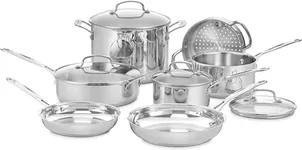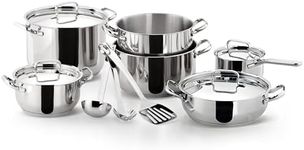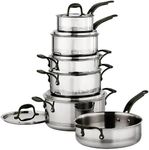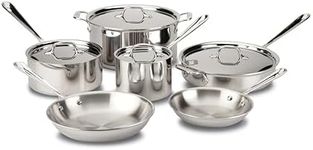Buying Guide for the Best Stainless Steel Cookware Sets
Choosing the right stainless steel cookware set can make a big difference in your cooking experience. Stainless steel is popular because it’s durable, non-reactive, and often looks great in any kitchen. When shopping for a set, it’s important to think about what you cook most often, how many people you usually cook for, and what features will make your time in the kitchen easier and more enjoyable. Understanding the key specifications will help you find a set that matches your needs and lasts for years.Material CompositionMaterial composition refers to the metals used in the cookware. Most stainless steel cookware is made from a combination of stainless steel and other metals like aluminum or copper, which are sandwiched in the base or throughout the pan. This is important because stainless steel alone doesn’t conduct heat very well, so adding aluminum or copper helps the cookware heat up more evenly and quickly. Sets with a 'fully clad' or 'tri-ply' construction (layers of metal throughout) offer the best heat distribution, while those with just an aluminum base are more affordable but may not cook as evenly. If you want consistent results and plan to cook a variety of dishes, look for fully clad options. If you mostly reheat or boil, a disc-bottom set may be enough.
Number and Types of PiecesThis spec tells you how many pots, pans, and lids are included in the set. It’s important because you want a set that matches your cooking habits. Sets can range from a basic 5-piece (usually a couple of pans and a pot) to 10 or more pieces with specialized items. If you cook simple meals or have limited storage, a smaller set may be best. If you like to experiment or cook for a family, a larger set with more variety can be more useful. Think about what you actually use—there’s no need to pay for extra pieces that will just sit in your cupboard.
Oven and Dishwasher SafetyOven and dishwasher safety refers to whether the cookware can be used in the oven and cleaned in the dishwasher. This is important for convenience and versatility. Some sets can handle high oven temperatures, which is great if you like to finish dishes in the oven or bake. Others may have plastic handles or lids that limit their oven use. Dishwasher-safe cookware makes cleanup easier, but hand washing can help your set last longer. If you want maximum flexibility, look for sets that are both oven and dishwasher safe, but always check the temperature limits and care instructions.
Handle and Lid DesignHandles and lids affect how comfortable and safe the cookware is to use. Handles should stay cool on the stovetop and feel sturdy in your hand. Some are riveted for extra strength, while others are welded for easier cleaning. Lids can be made of stainless steel or glass; glass lets you see your food as it cooks, but stainless steel is more durable. If you value comfort and safety, look for ergonomic handles and lids that fit well. If you want to monitor your cooking without lifting the lid, glass lids are helpful.
Compatibility with CooktopsThis spec tells you which types of stovetops the cookware can be used on, such as gas, electric, induction, or ceramic. Not all stainless steel cookware works on induction cooktops, which require a magnetic base. If you have or plan to get an induction stove, make sure the set is labeled as induction-compatible. For other cooktops, most stainless steel sets will work, but it’s always good to double-check. Pick a set that matches your current and future kitchen setup.
Weight and ThicknessWeight and thickness affect how the cookware feels and performs. Heavier, thicker pans usually heat more evenly and are less likely to warp, but they can be harder to handle, especially when full. Lighter pans are easier to lift but may not cook as evenly. If you have strength or mobility concerns, a lighter set may be better. If you want professional-level performance and don’t mind the extra weight, go for thicker, heavier pieces.
